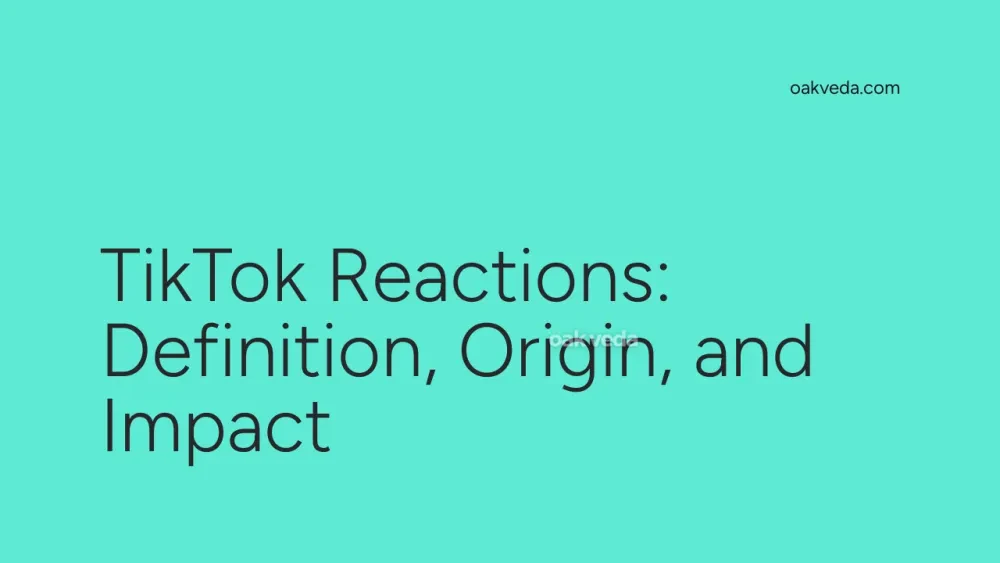
What is a TikTok Reaction?
A TikTok Reaction is an interactive video feature that allows users to respond to existing content on the platform. It enables creators to record their real-time reactions, thoughts, or commentary on another user's video, typically displayed in a split-screen or picture-in-picture format. This feature has become a cornerstone of TikTok's engagement strategy, fostering a more interactive and community-driven content ecosystem.
Origin and Development of TikTok Reactions
TikTok Reactions emerged as part of the platform's ongoing efforts to enhance user engagement and content creation possibilities. Introduced in 2018, this feature was inspired by similar functionalities on other social media platforms but tailored specifically for TikTok's short-form video format. The development of Reactions aligned with TikTok's goal of creating a more interconnected and responsive user experience.
How TikTok Reactions Work
Creating a TikTok Reaction is a straightforward process:
- Users find a video they want to react to
- They tap the "React" button, usually located in the share menu
- The original video appears on screen, often in a smaller window
- The user records their reaction while watching the video
- Both the original content and the reaction are combined into a new video
This seamless process allows for spontaneous, authentic responses and encourages creative interactions between content creators.
Types of TikTok Reactions
TikTok Reactions come in various forms:
- Side-by-Side Reactions: The original video and reaction appear next to each other
- Picture-in-Picture Reactions: The reaction video overlays a smaller version of the original content
- Green Screen Reactions: Users can use the green screen effect to superimpose themselves over the original video
- Duets: While not technically a "reaction," duets allow users to create content alongside the original video
Each type offers unique creative possibilities and ways to engage with content.
Popular Examples of TikTok Reactions
TikTok Reactions have spawned numerous viral trends and memorable moments:
- Dance challenge reactions, where users attempt to mimic or improve upon original choreography
- Comedy skits reacting to unusual or funny videos
- Expert commentary on educational or informative content
- Emotional reactions to powerful stories or performances
These examples showcase the versatility and appeal of the Reactions feature.
Impact of TikTok Reactions on Social Media Culture
TikTok Reactions have significantly influenced social media culture by:
- Enhancing Interactivity: Users can directly engage with content, creating a more dynamic platform experience
- Fostering Community: Reactions build connections between creators and audiences
- Amplifying Content: Popular videos gain additional exposure through reactions
- Encouraging Creativity: Users find innovative ways to respond to and build upon existing content
- Democratizing Content Creation: Reactions allow users to participate in trends without creating entirely original videos
This feature has redefined how users interact with content and each other on social media platforms.
How Brands and Influencers Use TikTok Reactions
Brands and influencers leverage TikTok Reactions to:
- Engage with their audience more personally
- Participate in trending topics or challenges
- Provide commentary or expert insights on relevant content
- Collaborate with other creators or brands
- Increase visibility and reach by reacting to popular videos
This strategy helps in building a stronger connection with their target audience and staying relevant in the fast-paced TikTok environment.
Future Trends Related to TikTok Reactions
As TikTok continues to evolve, we can expect to see:
- Advanced AR Integration: Augmented reality features may enhance the visual appeal of reactions
- AI-Powered Reactions: Artificial intelligence could suggest relevant videos to react to based on user preferences
- Cross-Platform Reactions: The ability to react to content from other social media platforms
- Monetization Opportunities: Creators may be able to earn revenue directly from popular reaction videos
- Enhanced Analytics: More detailed insights into how reactions impact engagement and reach
These potential developments could further cement TikTok Reactions as a crucial feature in the social media landscape.
FAQs about TikTok Reactions
-
Can anyone create a TikTok Reaction? Yes, all TikTok users can create reactions to public videos on the platform.
-
Do I need permission to react to someone's video? Generally, no. However, creators can disable the reaction feature for their videos if they choose.
-
How long can a TikTok Reaction be? TikTok Reactions follow the same time limits as regular TikTok videos, typically up to 60 seconds.
-
Can I react to a reaction video? Yes, users can create "reaction chains" by reacting to reaction videos.
-
How do TikTok Reactions affect video views? Reactions can significantly boost a video's visibility, potentially increasing views for both the original content and the reaction.
TikTok Reactions have revolutionized content creation and engagement on the platform. By allowing users to interact with and build upon existing content, this feature has created a more dynamic, creative, and interconnected social media experience. As TikTok continues to grow and evolve, Reactions will likely remain a central element in shaping the platform's unique culture and user interactions.
You may be interested in:
- AMOS: Definition, Origin, and Impact on Social Media
- Drag and Drop: Definition, Origin, and Impact on Social Media
- TikTok Duet: Definition, Origin, and Impact on Social Media
- TFW (That Feeling When): Definition, Origin, and Impact
- API in Social Media: Definition, Origin, and Impact
- Organic Reach: Definition, Origin, and Impact on Social Media

